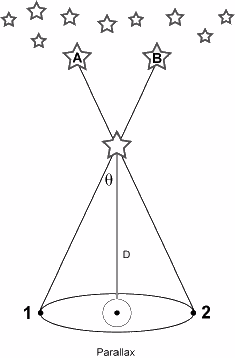
Stellar parallax the difference in direction of a celestial object as seen by an observer from two widely separated points. The measurement of parallax is used directly to find the distance of the body from the Earth (geocentric parallax) and from the Sun (heliocentric parallax). The two positions of the observer and the position of the object form a triangle; if the base line between the two observing points is known and the direction of the object as seen from each has been measured, the apex angle (the parallax) and the distance of the object from the observer can be found simply.

In the determination of a celestial distance by parallax measurement, the base line is taken as long as possible in order to obtain the greatest precision of measurement. For the Sun and Moon, the base line used is the distance between two widely separated points on the Earth; for all bodies outside the solar system, the base line is the axis of the Earth's orbit. The largest measured stellar parallax is 0.76", for the nearest star, Alpha Centauri; the smallest that can be directly measured is about 25 times smaller, but indirect methods permit calculation of the parallax, inversely proportional to the distance, for more and more distant objects but also with more and more uncertainty.
Excerpt from the Encyclopedia Britannica without permission.